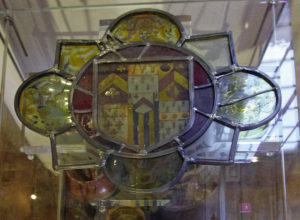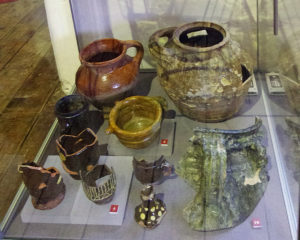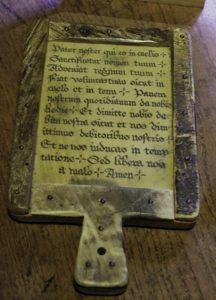Barley Hall, tucked away behind Stonegate is a recreation of a Medieval townhouse which had lain hidden and forgotten until recently. Now part of the York Archaeological Trust it is very much a hands on experience.
The timber frame building dated from the 1360s although it has been altered many times since then. It must be one of the oldest non ecclesiastical building in York. It was originally the York townhouse of the Priors of Nostell Priory, near Wakefield. As prebendary canons of York Minster, they were expected to attend ceremonies, services and business meetings in the city. The ground floor rooms were probably used for storage, with the day rooms and bedrooms on the first floor. The prior would have met guests and conducted business in the great chamber.
A new wing was added in 1430 but the priory fell onto hard times, partly due to the cost of rebuilding the priory church and a series of unsuccessful law suits. They had to lease out the building. At the time, it was one of the most expensive properties. It became the home of William Snawsell,a leading York citizen, a goldsmith and Lord Major of York who wanted a house to reflect his standing. His family lived in the house until the late 1480s.
After the Dissolution of the Monasteries, the building was confiscated by the crown. By the C17th it was divided up into smaller dwellings and by the C19th it housed tradesmen’s workshops.
The house was in very poor condition when it was bought by the York Archaeology Trust who carried out a full investigation and there was a major restoration/reconstruction of the hall, reusing as much of the medieval timber as possible. It was named Barley Hall after the Trust’s Chairman.
It is a typical Medieval hall house with a screens passage separating the living area from the kitchen and working areas. This passageway is a public right of way so there is no ground floor access between these two areas.
The ground floor has been furnished to what it might have been like when William Snawsell lived there. Entry is into the Steward’s room, although it is unclear what this room was used for in William Snawsell’s time. This leads into the vestibule with the great hall off. This is the most impressive room in the house with glazed tile floor and painted wall hangings. It would have had a central fireplace marked by a brick inset on the floor. William and important guests ate at the top table on a raised dais. The rest of the household ate at trestle tables and benches.
Across the screens passage were the kitchens, pantry and buttery.
The gallery, great and lesser parlours are on the first floor. The famous ‘horn window’ is here. These are used as an exhibition area. When I visited the exhibition was entitled “ Power and Glory: York in the time of Henry VIII”. Henry only visited York once with his new wife Katherine Howard. There is information about Henry and some of the costumes from the iconic BBC TV series the “Six Wives of Henry VIII” as well as the more recent “The Tudors”. Artefacts found during restoration are displayed here and there is also information about life in York, the Council of the North, the medieval guilds and the church.
Above the kitchen area, and probably kept warm by it, was the parlour where William would have conducted business.
All the furniture and fittings are modern replicas and it is very much a hands on experience as can sit on the chairs and handle the objects. There are a lot of information boards covering the history of the hall, William Snawsell and life in York.
Barley Hall isn’t the easiest place to find in York. It is tucked away down a narrow alleyway off Stonegate. Coffee Yard is just on the Minster side of the wooden banner ‘Ye Olde Starre Inne’ across Stonegate and nearly opposite Betty’s Cafe and Tea Rooms. Keep the ticket safe as it gives free entry to the property for a year. It is definitely worth finding.
DISABLED ACCESS
There is quite a large step into the shop and ticket area. There is an alternative entrance for wheelchair users, who need to attract the attention of the staff in the shop. The ground floor is accessible to wheelchair users, who may need to use temporary ramps into the rooms. The first floor is accessed by a steep staircase and there are no lifts. There is an interactive computer on the ground floor for visitors who can’t visit the upper floors. There are no disabled toilets.
Guide and assistance dogs are welcome. Braille guides are available.










